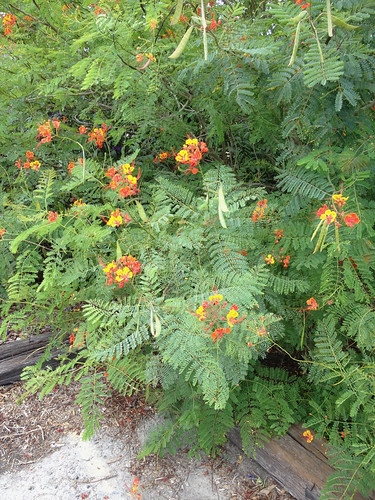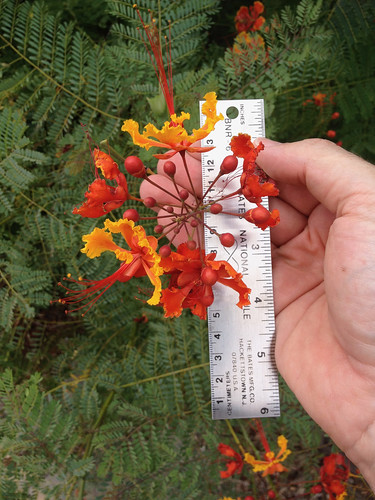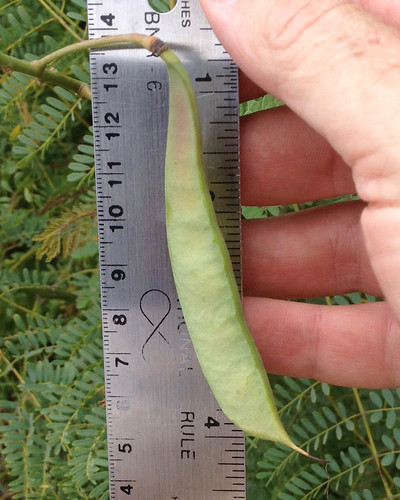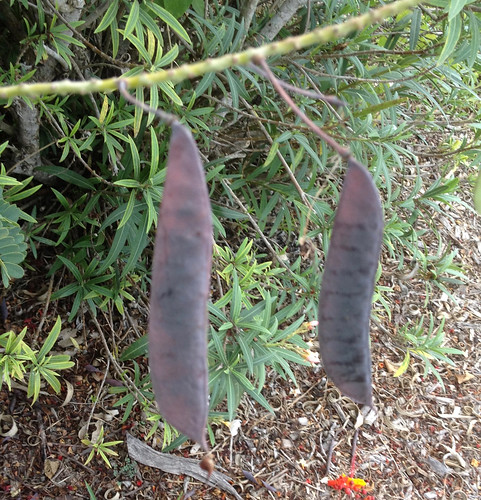Abundance: common
What: unripe seeds
How: cooked
Where: landscaping, full sun
When: spring, summer, fall
Nutritional Value: protein, calories
Dangers: ripe seeds are poisonous
Full plant in mid-summer will have both flowers and seedpods at different stages of maturity.

The red and orange flowers grow in clusters at the ends of branches and aren't edible.

The tender, green seedpods contain soft, edible bean seeds. The pod husks aren't edible.


The leaves are double-compound with the leaflets on the stems attached to the main leaf stem.
Texas distribution, attributed to U. S. Department of Agriculture. The marked counties are guidelines only. Plants may appear in other counties, especially if used in landscaping. Pride of Barbados plants are found all across Texas.
North American distribution, attributed to U. S. Department of Agriculture.
There are few landscaping plants as showy as the non-native Pride of Barbados bushes. Their round shape, complex leaves, bright flower clusters, and long pea pods draw attention and admiration. These bushes are very tolerant of Texas summers, actually preferring full sun. They can be planted in areas receiving as little as three hours of direct sunlight every day but they won't thrive and produces tons of blossoms with that much shade. The first year or two of planting they should be deeply watered 1-2 times a week but after that they become very drought tolerant. The USDA rates them hardy in zones 8 to 11. It may freeze and die back to the ground but fresh shoots will often appear in late spring when this happens.
The first thing noticed about this plant are usually the flowers. They produce clusters of five-petaled, red-centered, yellow/orange-tipped flowers with long stamen at the ends of many branches. The individual flowers can reach up to 3" across. Unopened flower buds are small, red balls with red stems, alternating along the end of the branch.
At the same time as the flowers (pretty much spring, summer, and fall) this plant will also have a variety of large pea pods, up to 5" long. When young these pods are green but turn a dark purple color upon maturity.
The stems are woody, ranging from green to brown in color and somewhat lumpy in texture. The bush grows multiple trunks, each branching several times.
Pride of Barbados leaves are compound twice-compound with the primary stems alternating along the branches and then the leaflet-bearing branches are opposite one another along the primary stem. The leaflets are oval in shape, have entire edges (no teeth or lobes) and opposite each other along the secondary stems. These leaflet appear in even numbers, with two growing out the end of the secondary stem.
The edible part of this plant are immature seeds taken from young, green seedpods. As the seed mature they become more and more poisonous. Though not deadly, they can cause a great deal of stomach distress if eaten too late. Younger seeds are always better than older seeds in the case of Pride of Barbados. The seeds are cooked by steaming or boiling before eating. Other cooking methods will work, too. The seed pod husks aren't eaten.
Buy my book! Outdoor Adventure Guides Foraging covers 70 of North America's tastiest and easy to find wild edibles shown with the same big pictures as here on the Foraging Texas website.




